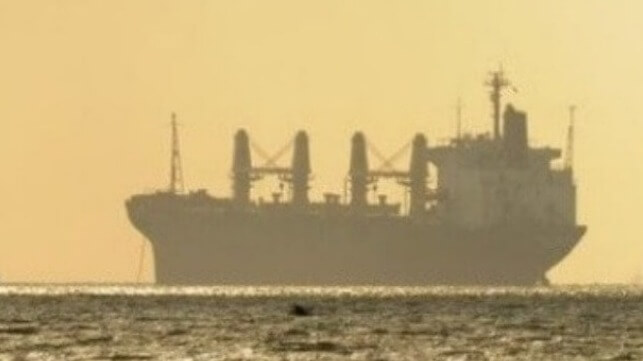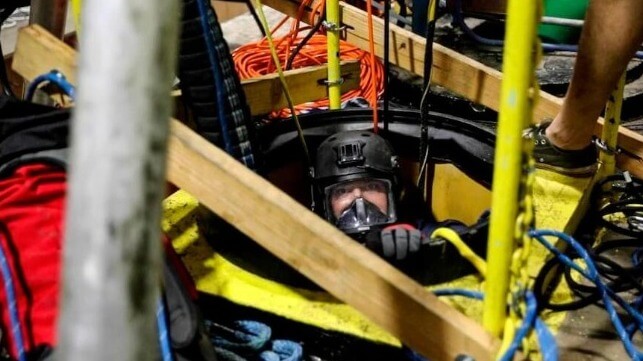ECOCIDE
Ammonium Nitrate-Laden Bulker Dumps Contaminated Cargo off UK

The Malta-flagged cargo ship Ruby with its cargo of 20,000 tons of ammonium nitrate fertilizer is again being drawn into a controversy weeks after the vessel found a safe refuge at Great Yarmouth in the UK. Local elected officials complained after the ship left port briefly over the weekend and returned on Monday, November 18, to continue offloading and transshipping the cargo.
The political leaders called for the government not to permit the ship to return to port citing the danger from the cargo which is seven times as much as the ammonium nitrate that caused the explosion in Beirut in August 2020. They blamed the Secretary of State while saying the ship should never have been permitted into Great Yarmouth in the first place.
Media reports surfaced that a portion of the cargo had been found to be contaminated making it less stable and potentially more dangerous. A spokesperson for Peel Ports which operates the facility would only say the ship briefly went to sea for “operational reasons.”
The media reports cited the fact the Ruby went approximately 11 or 12 nautical miles offshore and according to the AIS signal, was circling. The reports said the ship which departed Saturday, November 16, and returned Monday, November 18, dumped a portion of its cargo at sea.
The Maritime Coastguard Agency confirmed in a statement to the British press that “a small quantity of contaminated cargo was found,” and without providing details said, “This has now been successfully removed.” They said that inspectors from the government agency Health & Safety Executive would continue to monitor the vessel and the offloading process.
Environmentalists were quick to highlight the toxic nature of ammonium nitrate when it is exposed to seawater. They said it could accelerate algae growth and is detrimental to fish.
The Department for Transport responded to the criticisms saying that the operation was carried out with advice from the Maritime Coastguard Agency and HSE and that they had been assured that the vessel continues to meet safety standards. They called the decision to dock the bulker a “commercial decision” while highlighting there was no legal basis to refuse entry.
The plan agreed to in late October called for the Ruby to be berthed in the outer harbor at Great Yarmouth. She is to offload the cargo which is being transferred to another bulker also managed by Serenity Shipping of the UAE. The Barbados-registered bulker Zimrida (37,296 dwt) arrived in Great Yarmouth on October 29.
Some reports indicate a portion of the cargo has already been transferred between the ships but there is no indication how long the operation will require. There was speculation that the contaminated cargo had slowed the process.
The story began attracting international attention when Norwegian authorities at the beginning of September ordered the ship to leave Tromsø due to the explosive potential of the cargo. The managers ultimately complained that the media attention and misrepresentations of the cargo were complicating what should have been an ordinary transfer of the cargo. Norway, Sweden, Denmark, and Lithuania placed restrictions on the ship and rejected its entry into port. Its class society DNV and port state Malta agreed that the ship due to damage to the hull, rudder, and propeller, had restrictions and required a tug escort until repairs were completed.
US Navy Officials Missed Multiple Chances to Avoid Red Hill Disaster

The Pentagon's inspector general has concluded that the U.S. Navy didn't understand the spill risks involved in operating its Red Hill fuel tank site at Pearl Harbor, and it repeatedly failed to respond when a major spill finally occurred, exposing thousands of military family members to fuel-tainted drinking water.
The spill was a slow-rolling disaster, with multiple missed opportunities to intervene along the way. In May 2021, about 19,000 gallons of fuel were inadvertently pumped into a PVC drain line on the ceiling of an access tunnel. That overhead drain line sagged under the weight until it drooped low enough to get hit by a passing maintenance cart. The impact broke off a drain valve and spilled all the contents of the line onto the floor. The spill went on for 34 hours, and an unknown amount flowed into a water well located inside the access tunnel. That well fed the freshwater supply system for Joint Base Pearl Harbor-Hickam. About 4,000 military families were displaced from their homes because of contaminated water, and military doctors treated about 6,000 people for symptoms of fuel exposure and related illnesses. The cleanup and the planned closure of Red Hill will cost more than $2 billion.
During the course of the investigation, the IG determined that the Navy managers on site had limited knowledge of the facility and did little to ensure safe operation. They didn't even have an accurate map of their site: When inspectors visited the base library to look for up-to-date site plans, they found "documents overflowing into the hallway, a lack of labeling, and piles of engineering drawings scattered on various tables," and there was no librarian. After asking around and getting no answers, the IG team concluded that "Navy officials did not have accurate and up to date as?built drawings of [Red Hill's] tanks, pipelines, and supporting infrastructure."
The spill response plan for the Red Hill system didn't contemplate the possibility of a pipeline leak, even though the pipelines were kept filled with about 200,000 gallons of fuel each at all times. It also did not acknowledge the presence of a drinking water well inside Red Hill's access tunnel. "The bad assumption we made was that the tunnel system would be containment," one Navy official told the team. "There was no emphasis put on other potential impacts to the drinking water well, because we believed it would be contained in the tunnel."
In addition to a deficient response plan, the command conducted "no comprehensive fuel spill response drills" before the large-scale spill occurred, according to the Pentagon.
The IG also found evidence of deteriorating infrastructure, including corroding piping, and it learned that the facility's maintenance team was deferring up to 100 percent of new corrective tasks per month in order to address a backlog - despite "high levels of overtime." A shortage of technicians, lack of maintenance instructions and a lack of a work order system exacerbated the problem.
The team also found a lack of consistent lockout/tagout procedures, resulting in at least one prior spill and at least one serious safety hazard. The entire facility's fire suppression system was left locked out and disabled for more than a year, including a period when hot work was going on in the tanks and tunnels - and no notice was given to contractors that the site had no working firefighting system.
Additionally, the IG faulted the Navy for allowing a contractor to install the PVC drain line, instead of the stronger steel line originally specified in requirements - which would have been less likely to sag and might have prevented the spill.
On November 20, 2021, when the spill finally happened and it came time to mount a response, the Navy's site managers ignored their own spill response plan. They did not appoint one leader to manage the response as spill incident commander, and the designated incident manager for Pearl Harbor - the Navy On-Scene Coordinator Representative (NOSC-R) - did not even visit the site to look at it, either in May or November 2021.
As the spill unfolded on November 20-21, officials missed multiple opportunities to prevent exposing servicemembers and their families to contaminated water, because they did not activate the base-wide emergency response plan. Red Hill's managers assumed that the spill was contained in a sump on the 20th, and even after examining the scene in more detail on the 24th, they failed to identify clues that the well had been contaminated. They didn't immediately check or sample the well to see if there was fuel in it - even after instructed to do so by the Hawaii Department of Health.
On the 27th, Base Pearl Harbor-Hickam got the first complaint of a chemical odor in drinking water on base. No action was taken.
The number of complaints rose on November 28, and officials began to suspect water contamination, but even then they did not activate the base-wide drinking water emergency response plan. "In sum, Navy officials missed four opportunities to activate the [water system response plan]," the IG concluded.
The Hawaii Department of Health took over and issued an advisory not to drink or use the base's tap water on November 29, and on December 6, it ordered a full shutdown of the Red Hill tank farm and a cleanup treatment of the drinking water system. Lab testing of the tapwater revealed elevated concentrations of aromatic hydrocarbons in the benzene, toluene, ethylbenzene, and xylenes (BTEX) group of chemicals, which were potentially consumed by thousands of base personnel.
To prevent future tragedies, the IG called for better spill detection and response planning. "The DoD must take this action, and others, to ensure that tragedies like the one in November of 2021 are not allowed to repeat," Inspector General Robert P. Storch said in a statement, noting that the Navy still operates a large fuel transfer hub at Pearl Harbor. "Our recommendations include that the DoD assess leak detection systems at other Navy fuel support points."
Hawaii's congressional delegation called the findings "outrageous and unacceptable."
"The Navy must take full responsibility for its failures and immediately implement the recommendations from the Inspector General in order to address the ongoing impacts to public health and the environment," said Senators Brian Schatz and Mazie Hirono and Representatives Ed Case and Jill Tokuda [D-HI].
No comments:
Post a Comment